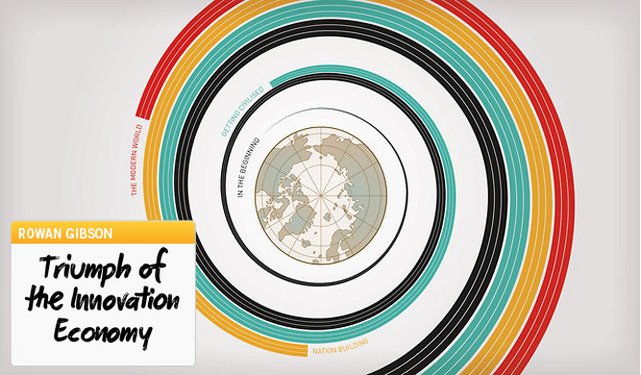
Triumph of the Innovation Economy part 1
By Rowan Gibson, published at Innovation Excellence reedited by Hugowiz

By Rowan Gibson, published at Innovation Excellence reedited by Hugowiz
Over the last decade, innovation has clearly moved to center stage in terms of strategic priorities – not just for the world’s business leaders but for economists and savvy politicians, too. In fact, we’ve heard so much about it in recent years that some misguided folks already view innovation as nothing more than a management fad or the latest business buzzword.
With this series of articles, I want to put that notion to rest.
To anyone who believes that innovation is merely the flavor of the month for business journalists, trendy consultants, corporate executives, economic advisors, or government officials, my message is this: take a good look back through history. What you will very quickly conclude is that innovation has been around since we first had the idea to turn rocks into tools, or discovered how to make fire, or invented the wheel, or came up with cuneiform communication on clay writing tablets. Innovation is part of what makes us human.
I would argue that the entire history of the world is a history of creativity, invention, and innovation.
In the many millennia of our existence, there has never been a time when humans were not generating new ideas to make life easier and better for themselves in some way. I invite you to join me on a short journey through time to verify and validate this argument.
Let’s go all the way back to the ancient Natufians – considered to be the world’s earliest culture – who settled in the Levant region of the Eastern Mediterranean (between modern-day Israel and Jordan).
Archeological evidence tells us that they were a very innovative society.
For example, they developed the practice of archery to hunt for gazelles and wild boar; they designed harpoons, fish hooks and nets to catch fish; and they created tailor-made tools and methodologies – such as harvesting sickles, heavy bowl mortars, grinding stones, and storage pits – to help them cultivate and make use of cereals, fruits, and nuts. Indeed, they appear to have been the world’s first culture to practice agriculture. They also built villages with hundreds of round, dry-stone houses, each with a central fireplace. They turned ostrich shells into storage containers. They kept dogs as pets. And they fashioned stones, bones, teeth and shells into jewelry – including beads, bracelets, pendants, earrings, and necklaces. They even carved artistic ornaments out of limestone, like representations of animals and human figurines. In fact, the Natufians produced the world’s oldest known depiction of a couple making love – a carved stone object called “the Ain Sakhri lovers” which can be seen today in the British Museum.
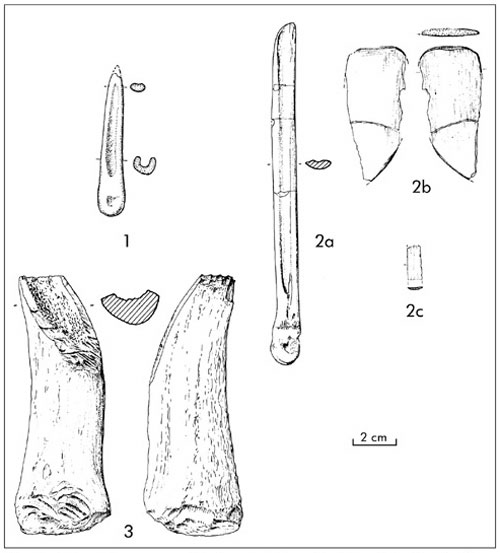
The Ubaidians, who lived later in southern Mesopotamia (now southern Iraq and Kuwait), were pioneers in irrigation agriculture, figuring out how to drain marshes and build extensive networks of canals, which allowed them to plant and grow grains in extremely arid conditions. They also established specialized industries and occupations such as masonry, metalwork, weaving, and leatherwork, and were particularly known for a distinctive style of painted pottery.
These industries gave rise to a booming regional economy and a trading system that reached all the way from the Mediterranean coast to the Persian Gulf.
The great Sumerian people that came to flourish in this region built what are held to be the world’s first cities, Uruk and Eridu, with large ziggurat temples and royal palaces as their central structures. They developed new architectural forms such as arches and domes, and constructed buildings using buttresses, recesses, half columns, and clay nails. The success of their irrigated farming and soil replenishment methods led to large surpluses of food which were stored in temple granaries. This attracted more and more people to come and live in the Sumerian cities, which grew in number and size, and the urban population gradually rose to unprecedented levels in the region.
Uruk became the most urbanized city in the world at that time, and at its height is said to have had between 50,000 and 80,000 inhabitants.
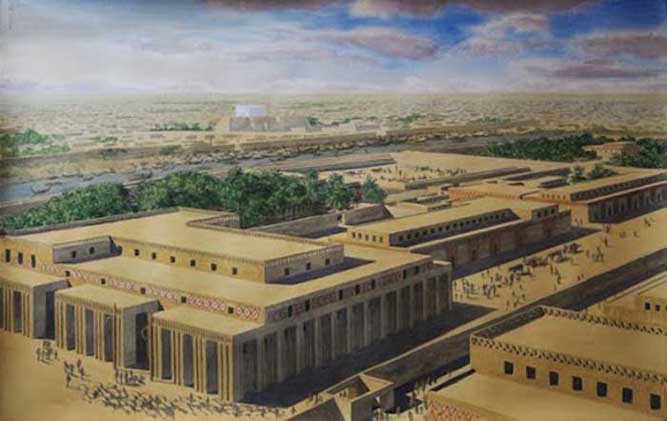
The residents of these city states lived in mud-brick homes with fire-places and chimneys, and some had gardens with trees and other plants. People owned beds, chairs and other furniture with elaborate carvings, and these items were made by skilled craftsmen using saws, drills, hammers, chisels, nails and glue.
The Sumerians invented arithmetic, geometry, algebra, and the abacus, as well as the sexigesimal system of counting (based on the number 60), which led to the 60-second minute and the 60-minute hour.
They also created the concept of a 24-hour day, with two periods (night and day) of 12 hours each. They defined a “work day” of a limited number of hours, with specific start and end times, and allocated “days off” for recreation. They were the first to introduce social stratification, and the concept of property. They made advances in astronomy, mapping stars into constellations, identifying all five planets which are visible to the naked eye, and calculating time in lunar months. They also enjoyed music, perfecting and popularizing the lyre – the stringed instrument of antiquity. It is also believed that the Sumerians invented the first oboe-like instrument, which was apparently used at royal funerals.
Perhaps the most famous contribution the Sumerians made to human progress was their writing system – originally a means of trade communication – which evolved into the common use of cuneiform on clay tablets. The Sumerians eventually produced many thousands of tablets on which they recorded financial accounts, transactions, debt/payment certificates, inventory lists, receipts, letters, laws, history, stories, hymns, prayers, and other texts.
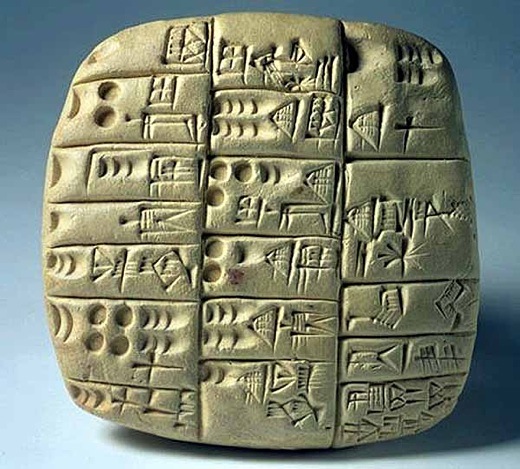
However, the Sumerians innovated in many other breakthrough ways, too. For example, they developed the earliest known potter’s wheel, which was made of stone. This concept then inspired them to create heavy, rounded mill wheels for grinding their cereal crops, and with their next logical step they revolutionized transportation: the Sumerians produced the first wheeled vehicles such as carts and chariots resting on two or four wheels, pulled by oxen or donkeys.
They also designed and built some of the first boats with bitumen waterproofing, and wooden-oared ships for transporting people and cargo on their trade routes. They developed the first codified legal systems, using courts and jails to maintain order in their society. They kept government records to manage city administration. They established the first formal schools. They introduced the world’s first aquarium. They learned to brew beer from barley grains, and figured how to use animal bladders as water skins. Their soldiers were equipped with sandals, boots, swords, daggers, scabbards, axes, knives, lances, arrow quivers and war chariots.
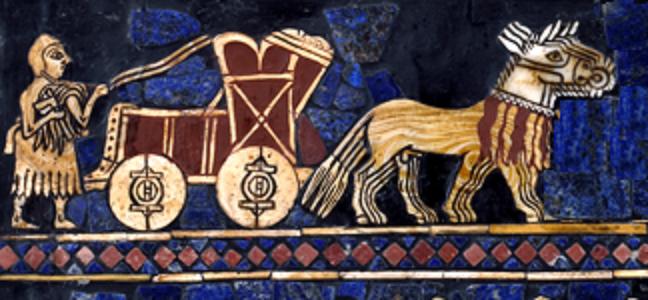
It has been said that the Sumerians were the creators of civilization. The late Samuel Noah Kramer, a world-renowned expert on Sumerian culture, wrote of “the crucial role the Sumerians played in the ascent of civilized man”. The impact of their innovations on the rest of human history – and on our lives today – cannot be overstated. In his book History Begins at Sumer Kramer lists 39 “firsts” from the Sumer region, asserting that “no people has contributed more to the culture of mankind than the Sumerians.”
If the ancient peoples of Mesopotamia – the “Cradle of Civilization” – laid the original foundation for human progress through innovation, how was this foundation used and improved upon by the societies that followed them? Find out in the next article in this series.

Rowan Gibson's new book The Four lenses of Innovation examines the thinking patterns or perspectives that have been catalysts for breakthrough innovation throughout human history, and shows you how to use these perspectives to infuse creativity into your own organization.
Order your copy right here.
Rowan Gibson (rg@rowangibson.com) is recognized as one of the world’s foremost thought leaders on innovation.
He is the internationally bestselling author of 3 major books, an award-winning keynote speaker in 60 countries, and a cofounder of Innovation Excellence.
His new book is The Four lenses of Innovation.
On Twitter he is @RowanGibson.
You will receive news about new articles, events and workshops about innovation sent by Hugowiz.